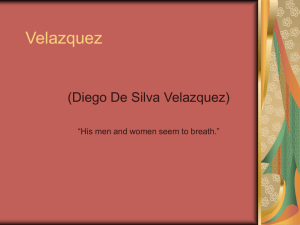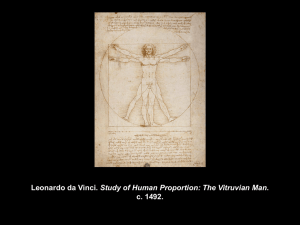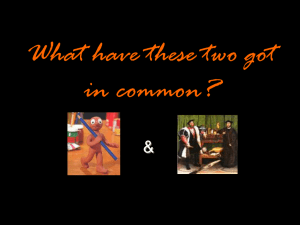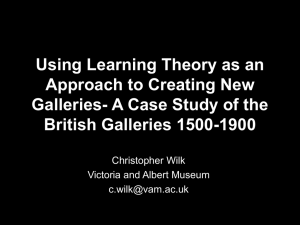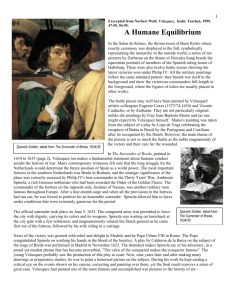Lecture 3 - Perspective and the Subject of Reason
advertisement
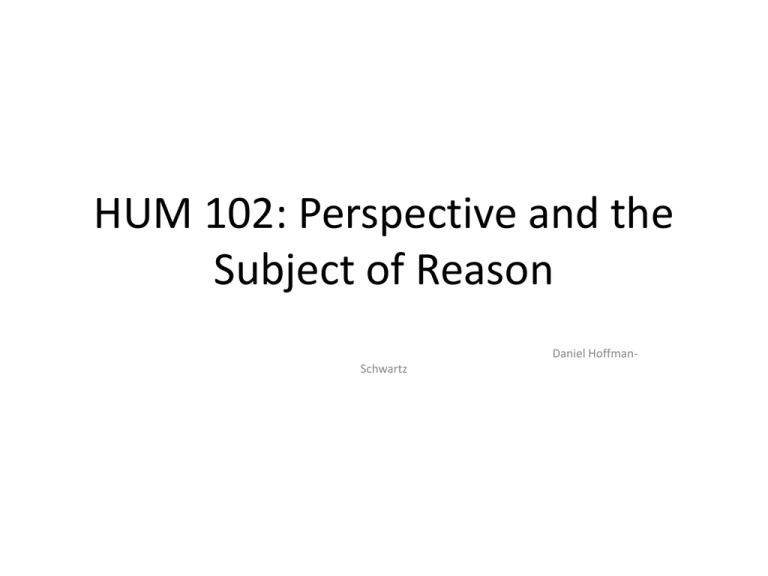
HUM 102: Perspective and the Subject of Reason Daniel HoffmanSchwartz Subject • Modernity of described in terms of ‘the Rise of the Subject’ • Term with complex history and multiple definitions that are in tension with one another. Subject •In everyday usage, “subjective” means “based on or influenced by personal feelings, tastes, or opinions”; i.e., not “objective” (scientific, rational, etc.). Subject • But we might also think of the term “subject” in grammar: the agent or actor in a sentence. E.g.,“The dog [subject] bites the man [object].” Subject •Also an older, legal-political sense with which you might be familiar: “one that is placed under authority or control”; e.g. being a subject of the King or a subject of the Law. •This noun echoes an adjective and a verb: to be subject (adjective) to the King or indeed to be subjected (verb, past-tense) to the King. (Subjectum, Latin, ‘to be thrown under’) Subject • None of these senses is the technical, philosophical sense of the term “subject”, though each of these is related to it. • Though Descartes does not use the term “Subject,” the Cartesian “I think”/Cogito is often described as the foundation of the modern concept of the subject. Subject • Cartesian (17th century) “Subject”: a being defined by consciousness and selfconsciousness. • Paradox of Post-Cartesian (i.e., modern) ‘Subjectivity’: it is by way of the Subject (cogito) that we arrive at scientific Objectivity. Subject • Enlightenment (18th century) Expansion and Formalization of Subject: Subject judges and evaluates (its own) representations of the world; world appears for Subject. • Subject now also associated with universality: everyone is already or should become subject of reason. The Subject Revised • What if becoming a subject (of reason, of freedom) also means being subject or subjected, literally ‘thrown under’ (Latin: subjectum)? The Subject Revised • The example of language: in order to speak one must first accept the rules of language. All mastery, creativity, or expression within language requires submission or subjection to language as a system. • The “I”; the source of subjectivity in language is precisely an impersonal generality; in order to become a subject in language, one must give oneself up to this generality. Review/Summary • Double-structure of Subject in Modernity: • On one side, consciousness and selfconsciousness; freedom and reason; mastery • On the other side, subjectivity presupposes subjection to language, representation, institutions. Perspective • In the most basic sense, perspective or linear perspective is a technique for visually representing a 3-dimensional world on a flat (2dimensional) surface. • From the Latin perspectiva (literally, ‘seeing through’). • It is so natural for us that we hardly notice when it is being used in visual media, but it in fact has a history (i.e., it wasn’t always there) and can be dated in its dominant form to the 15th century. • In perspectival painting, the flat surface attains imaginary depth and comes to resemble a window ‘through which’ one sees the world. • Negation of actual material surface of canvas • “Picture plane”: the outer surface of the imaginary depth of the picture. • Perspective, in other words, simulates a continuity between ‘real space’ and ‘represented space,’ and the “picture plane” is the threshold or border between these two kinds of space. Antonello, St. Jerome in His Study (1460-1475) Medieval Painting (Ca. 1125) Figurative, “flat” (i.e. non-perspectival) 20th Century Painting (Jackson Pollock, Full Fathom Five, 1947); flat, abstract Beni Mguild, 1960 (Moroccan tapestry) Basic Principle of Perspectival Construction: The Grid •The perspectival window must be covered with an (invisible or removable) grid that allows for the ‘translation’ between ‘depth’ and ‘flatness.’ •Marking points between ‘object, picture plane, and lines of vision’ Visual Pyramid Albrecht Altdorfer, Study for Birth of the Virgin (1520) Albrecht Altdorfer, Birth of the Virgin (1520) Albrecht Dürer, Man Drawing Reclining Woman (1525) Basic rules of perspective • Vanishing point: the ‘back’ of the imaginary depth, where the painting ends; most obvious illustration of vanishing point is principle that parallel lines converge at the vanishing point. • All perpendicular or “orthogonal” lines meet at this vanishing point. ‘Result’ of Perspectival Construction: • Infinite, unchanging, homogeneous, rationalmathematical space. • But: this requires an immobile spectator, who must – physically or in imagination – place himself at the correct distance from the image. Melozzo, Fresco at Loreto (1484) Tension between Subjectivity and Objectivity? • On one hand, perspective makes the human subject the new center, the point of orientation for the image. • On the other hand, it ultimately posits an infinite, ‘a-centric’ space. Antonello, St. Jerome in His Study (1460-1475) Antonello, St. Jerome in His Study (1460-1475) • ‘Objectivism’ of perspective: frontal view, ‘straight’ approach to world; St. Jerome at a sharp right angle to spectator. • Coordination of viewpoint of spectator with orientation of represented architecture. Spectator conforms to architecture and ‘structure.’ • Picture plane functions as window and as limit. Antonello, St. Jerome in His Study (1460-1475) Dürer, St. Jerome in his Study (1514) Dürer, St. Jerome in his Study (1514) • Picture plane does not coincide with opening of represented space; ‘we’ share space with St. Jerome. • Oblique (‘crooked’) angle signifies freedom to take one’s own viewpoint on the world; perspective is not ‘lined up’ with a represented architectural structure. Dürer, St. Jerome in his Study (1514) ‘Ideological’ Resolution of Tension between Subjectivity and Objectivity… •‘Ideological’ resolution: both are expressions of ‘human greatness’; art plus science; the ideal of Renaissance Humanism… •Re-centering of man, even though we know the universe has no center. •What is hidden by this self-celebration of Man? Proto-Perspectival Painting • Conflict between theological space (theocentrism) and mathematical space. • On one hand, space of church/altar is marked off as having special transcendent value, place where infinite God *somehow* appears. • On the other hand, there are also aspects of mathematically infinite space. • So: mathematization of space emancipates man from theo-centric hierarchy. Lorenzetti, Annunciation (1344) Lorenzetti, Annunciation (1344) • Proto-perspectival system: tiles on floor allow spectator to mark depth in picture – element of infinite/mathematical space but: • This space is framed within picture as a heterogeneous (‘special,’ ‘theological’) space; • Gabriel and Mary looks upwards towards absent or unrepresentable infinity of God • Conflict between homogeneous mathematical space and ‘hierarchy of being(s).’ Lorenzetti, Annunciation (1344) Lorenzetti, Presentation at the Temple (1342) Botticelli, Primavera (1481-1482) Panofsky, Perspective as Symbolic Form (1927/1991) Or Structure of Subject/ion? • One becomes a Subject by Subjecting oneself to the image. • Subject: world appears as if ‘for me’; is perfectly rational and intelligible • Subjection: but only if I place myself in the position dictated to me by the painting. • Analogy with language: I become subject in language only by accepting rules, structure, system of language. Subject as Assimilation to Space: Camouflage Antonello, St. Jerome in His Study (1460-1475) Dürer, St. Jerome in his Study (1514) Psychoanalysis • The Psychic ≠ The Conscious; ‘discovery of the unconscious’ (Freud). • The Visual ≠ The Visible. In other words: can we ‘see’ the unconscious? What is the unconscious in images? (Lacan) Psychoanalysis • What do I not see, precisely because I have taken immobile position of Subject? • What if something (that I can’t see) is looking at me? • (Jacques Lacan, 4 Fundamental Concepts of Psychoanalysis, “Of the Gaze as Objet Petit a”) Hans Holbein, The Ambassadors (1533) Hans Holbein, The Ambassadors (1533) • Image of human mastery: objects from all domains of human knowledge (arts and sciences), but also from various ‘discovered’ parts of the earth (Oriental rug); presence of globe suggests sovereignty and rational knowledge of totality. • Ambassadors: ideal representations of European Man. Hans Holbein, The Ambassadors (1533) Hans Holbein, The Ambassadors (1533) • But what can’t they see? What can’t we see? • What’s this peculiar object in the foreground of the image? (Or at the bottom of the image?) • Tilt your head! Can anyone see it? Hans Holbein, The Ambassadors (1533) Anamorphic skull Anamorphosis/the blind spot • There is no unitary viewpoint from which this image can be apprehended, in spite of the fact that it seems to represent totality itself. • Technique of anamorphosis (ana-, ‘again’ or ‘back’; morphe, ‘form’); ‘reverse perspective,’ hiding another form or image within the image. Hans Holbein, The Ambassadors (1533) Anamorphosis/Gaze • Not everything in the image is visible; it is as if the image sees me. (Lacan: ‘the gaze,’ ‘the stain) • The skull serves to remind us that the ‘Ambassadors’ will die and that we will die; presents us from enjoying our own identification with mastery and human greatness. Anamorphosis/the blind spot • But this is also achieved through scientific knowledge and technique. • This images ironizes or takes apart Renaissance humanism; it uses science but interrupt human self-celebration. Jacques Lacan, 4 Fundamental Concepts of Psychoanalysis (1964/1973/1977) Velazquez, Las Meninas (1656) Velazquez, Las Meninas (1656) • A painting engaged with tradition of royal portraiture. • Again, a question of relation between two kinds of space and two kinds of infinity. • Representing the sovereign (who has link to God, transcendence) within homogeneous, rational space of perspective. Velazquez, Las Meninas (1656) Velazquez, Las Meninas (1656) Velazquez, Las Meninas (1656) • Where are the King and Queen? • The figures reflected in the mirror appear to be King Philip IV and his wife Mariana (who sponsored Velazquez). • Where are they? Based on the reflection, they must be where ‘we’ are, the position of the spectator. Possibility of exchange of position between sovereignty and impersonal general spectator… Velazquez, Las Meninas (1656) Velazquez, Las Meninas (1656) Velazquez, Las Meninas (1656) • Sovereign or Subject (or Sovereign-Subject) as absent center. • Dissolution of Sovereign and Subject in play of relations/difference. • Representation of system of Perspectival Representation Picasso, Las Meninas Michel Foucault, The Order of Things (1966/1970)


